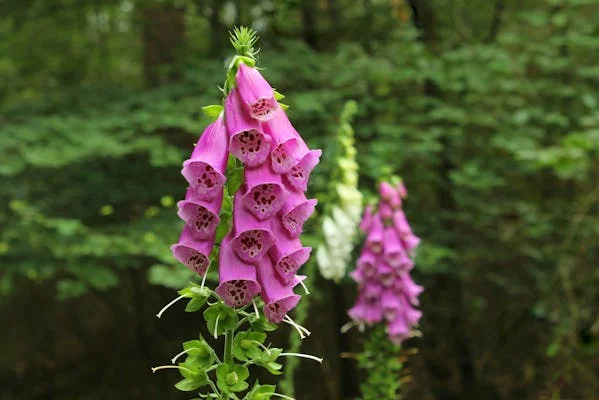Gumshoe foxglove, a hybrid plant in the Digitalis genus, is renowned for its upright growth and bell-shaped flowers. It is a cross between two species: Digitalis purpurea (common foxglove) and Digitalis grandiflora (great yellow foxglove). This hybrid was first developed in the early 20th century by the famous plant breeder and horticulturist, Sir Frederick Merton. The result is a plant that combines the elegance of its parent species while maintaining unique qualities that set it apart in the garden. Gumshoe foxglove is valued for its beauty, ease of care, and long blooming period. It has become a popular addition to flower beds, border gardens, and even container plantings. Its blooms are typically found in shades of pink, purple, and sometimes even white. But what truly makes this plant stand out is its ability to thrive in a wide range of growing conditions.
Understanding the Characteristics of Gumshoe Foxglove
Unique Appearance
Gumshoe foxglove features tall, elegant spikes that can reach up to 3 feet in height. These spires are adorned with tubular flowers, which bloom from the bottom upwards. The flowers, which resemble small bells, come in various shades of pink, purple, and occasionally, cream. The leaves of the gumshoe foxglove plant are broad, dark green, and slightly fuzzy, adding to its attractive appearance.
Hybrid Vigor
As a hybrid plant, gumshoe foxglove enjoys what is known as “hybrid vigor” – a phenomenon where hybrid plants exhibit stronger growth, better disease resistance, and greater adaptability than their parent species. This means that gumshoe foxglove tends to grow more robustly, making it easier to cultivate and maintain.
Flowering Period
One of the standout features of gumshoe foxglove is its extended flowering period. Unlike many plants that bloom for just a few weeks, gumshoe foxglove flowers from late spring to early summer. This extended blooming season ensures that your garden will remain vibrant throughout the growing season.
Benefits of Growing Gumshoe Foxglove
Adds Color to Any Garden
Gumshoe foxglove is prized for its colorful, bell-shaped blooms, which make a dramatic statement in any garden. Whether you’re creating a border garden, a wildflower patch, or a mixed perennial bed, gumshoe foxglove will add color and dimension to your landscape. Its striking flowers attract pollinators like bees, butterflies, and hummingbirds, making it an excellent choice for wildlife gardens.
Easy to Grow and Maintain
One of the major advantages of gumshoe foxglove is its relatively low-maintenance nature. While it requires well-drained soil and partial to full sun, it does not demand constant attention. It is drought-tolerant once established, making it an excellent plant for gardeners in regions with unpredictable rainfall. Moreover, its resistance to common diseases means fewer worries for gardeners compared to more delicate plants.
Ideal for Pollinators
As a member of the Digitalis genus, gumshoe foxglove attracts pollinators, including bees and butterflies. Its tubular flowers provide the perfect landing pads for these insects, allowing them to access the nectar and pollen within. This makes it a valuable addition to pollinator-friendly gardens, promoting a healthy ecosystem and biodiversity.
Growing and Caring for Gumshoe Foxglove
Best Growing Conditions for Gumshoe Foxglove
Gumshoe foxglove thrives in well-drained, fertile soil that is slightly acidic to neutral in pH. When selecting a planting location, choose a spot that receives partial to full sun. Although gumshoe foxglove is relatively adaptable, it tends to do best in environments that offer protection from extreme heat, particularly in areas with hot summers. If you’re planting it in an area with intense sun, provide some afternoon shade to protect it from the harshest conditions.
Soil Preparation
For optimal growth, prepare the soil before planting by ensuring it is loose and well-draining. Incorporate organic matter such as compost to improve the soil’s texture and fertility. If your soil is clay-heavy, consider mixing in sand or perlite to improve drainage. Gumshoe foxglove does not do well in soggy or waterlogged soil, so good drainage is essential.
Watering and Fertilizing
Once planted, gumshoe foxglove should be watered regularly, particularly during dry spells. However, it is important to avoid overwatering, as this can lead to root rot. Deep watering is ideal, as it encourages the roots to grow deeper into the soil, promoting stronger, healthier plants. Mulching around the base of the plant can help retain moisture and reduce the need for frequent watering.
Gumshoe foxglove benefits from occasional fertilization. During the growing season, apply a balanced fertilizer once a month to support strong growth and vibrant blooms. Be sure to follow the manufacturer’s instructions to avoid over-fertilizing, which can harm the plant.
Pruning and Deadheading
To maintain the appearance of your gumshoe foxglove plant, it is recommended to remove spent flowers regularly. This process, known as deadheading, encourages the plant to produce more blooms. If the plant becomes too tall or leggy, you can also prune back the stems to promote a fuller, bushier shape. However, avoid cutting back the foliage too aggressively, as this can harm the plant.
Overwintering Gumshoe Foxglove
Gumshoe foxglove is a hardy perennial in most temperate climates. In colder regions, it may die back in the winter but typically reemerges in the spring. To protect it from harsh winter conditions, you can apply a layer of mulch around the base of the plant. This helps insulate the roots and prevents them from freezing.
Common Pests and Diseases
Although gumshoe foxglove is relatively resistant to pests and diseases, there are a few issues to watch out for.
Aphids
Aphids are small, sap-sucking insects that can occasionally infest gumshoe foxglove. They can be controlled using insecticidal soap or by encouraging natural predators like ladybugs.
Powdery Mildew
Powdery mildew is a fungal disease that can affect gumshoe foxglove in humid conditions. To prevent this, ensure that the plant has adequate airflow around it, and avoid overhead watering. If powdery mildew appears, treat the plant with a fungicide or a natural remedy like a baking soda solution.
Slugs and Snails
Slugs and snails may be attracted to the tender leaves of gumshoe foxglove, especially in damp conditions. These pests can be controlled by using organic slug repellents or by placing copper tape around the base of the plant.
Gumshoe Foxglove: A Versatile Addition to Any Garden
Whether you’re a seasoned gardener or a novice, gumshoe foxglove offers a stunning and low-maintenance option for adding beauty and color to your landscape. Its vibrant blooms, adaptability, and ability to attract pollinators make it a fantastic choice for various garden types. By following the proper growing guidelines, you can enjoy this striking hybrid plant for many years to come.
Conclusion
Gumshoe foxglove is a wonderful addition to any garden, combining aesthetic beauty with practical benefits such as attracting pollinators and providing low-maintenance care. By understanding its origins, growth habits, and care requirements, gardeners can maximize the plant’s potential and create a thriving garden filled with colorful, bell-shaped flowers. Whether you’re growing it for its beauty or its ecological benefits, gumshoe foxglove is truly a plant worth considering for your garden.
FAQs About Gumshoe Foxglove
1. What is gumshoe foxglove?
Gumshoe foxg love (Digitalis x mertonensis) is a hybrid plant that combines two species: Digitalis purpurea (common foxglove) and Digitalis grandiflora (great yellow foxglove). It is known for its tall spikes of bell-shaped flowers in shades of pink, purple, and white, making it a popular choice for gardeners.
2. How tall does gumshoe foxglove grow?
Gumshoe foxg love can reach a height of 2 to 3 feet (60 to 90 cm) when fully grown. Its tall, elegant spikes are one of the reasons it’s so attractive in garden settings.
3. How do I plant gumshoe foxglove?
To plant gumshoe foxg love, choose a location that receives partial to full sun and has well-drained soil. It prefers slightly acidic to neutral soil. Dig a hole large enough for the root ball, place the plant in the hole, and fill it with soil. Water the plant thoroughly after planting.
4. When does gumshoe foxglove bloom?
Gumshoe foxglove typically blooms in late spring to early summer. Its flowers appear in a range of colors, including pink, purple, and sometimes cream, lasting for several weeks.
5. Does gumshoe foxglove require full sun?
Gumshoe foxglove thrives in partial to full sun. While it can tolerate some shade, it performs best when it receives around 4 to 6 hours of sunlight per day.






